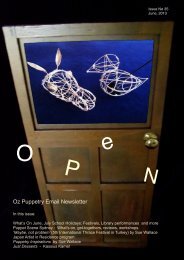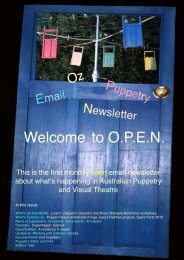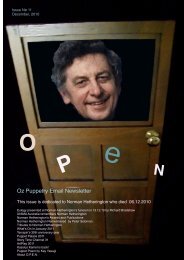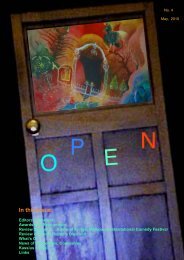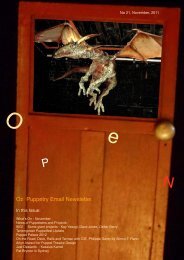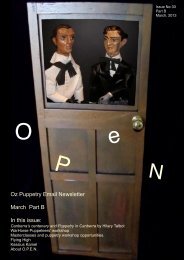O
Oz Puppetry Email Newsletter - Dream Puppets
Oz Puppetry Email Newsletter - Dream Puppets
- No tags were found...
Create successful ePaper yourself
Turn your PDF publications into a flip-book with our unique Google optimized e-Paper software.
REVIEW<br />
A Touch of Thai:<br />
“Joe Louis Live in Sydney”<br />
at the Sydney Opera House<br />
By Kay Yasugi<br />
Last month I attended a fantastic free event<br />
organised by the Royal Thai Consulate at the<br />
Sydney Opera House. The show was “Joe Louis<br />
Live in Sydney”, which was a one hour showcase of<br />
traditional Thai puppetry. Joe Louis (also known as<br />
Sakorn Yangkhiawsod) was the one of Thailand's<br />
top puppet masters and the country's last 'Grand<br />
Master' of the Thai puppet art form known as Hun<br />
Lakhon Lek. His troupe now travels around the<br />
world to share his legacy of amazingly crafted<br />
puppets. This show consisted of various acts,<br />
including a demonstration of traditional Thai dance<br />
and an excerpt from “The Ramayana” epic<br />
(“Ramakien” in Thai), which is the most popular play<br />
performed by the troupe.<br />
On first glance, the puppetry looked similar to the<br />
Japanese style of Bunraku (Ningyo Joruri), as each<br />
puppet was operated by three performers – two<br />
controlling the arms/head and one controlling the<br />
feet. Like Bunraku, the puppets have a somewhat<br />
fragmented existence – they dance and move on<br />
stage while their voice comes from elsewhere: a<br />
cluster of musicians for Traditional Thai chanting,<br />
cymbals and drums – producing sounds ranging<br />
from the dramatic to the soothing and almost<br />
hypnotic. However, there are distinct differences<br />
between the art forms. For example, all the<br />
puppeteers’ faces are in full view (whereas in<br />
Bunraku, only the master puppeteer shows his<br />
face). Unlike the ‘invisible’ puppeteers of Bunraku,<br />
the Thai puppeteers are very much part of the<br />
performance. They work in tandem with the puppet,<br />
mimicking gestures and facial expressions like<br />
ripples in a pond. The puppets also ventured out<br />
into the audience, greeting them (and even<br />
borrowing a lady’s handbag, to the great<br />
amusement of the crowd).<br />
As an incredibly rare treat, the audience was invited<br />
at the end of the show to come up and see the<br />
puppets (and even touch them!). This was a<br />
wonderful opportunity to have a look at the<br />
ingenious rod mechanisms of the puppets, which<br />
allowed their wrists to flick, wave and even pray.<br />
The puppeteers use their thumbs to control small,<br />
grooved spools embedded in the rod handles, which<br />
are connected with string to the wooden hands of<br />
the puppets like miniature pulleys. It was amazing to<br />
see how the performers delicately and skilfully<br />
operated the control to achieve subtle nuances in<br />
movement.



